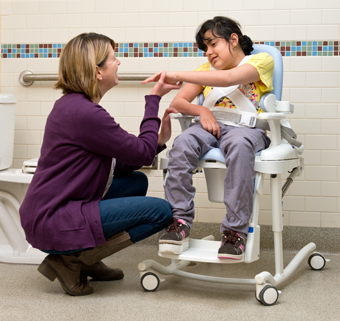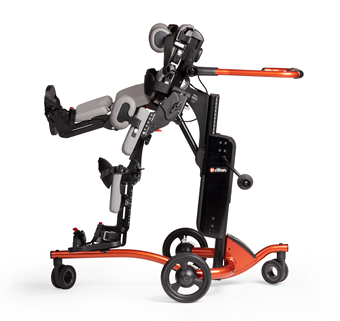Evidence Update
The Relationship of Trunk Support to Head Stability in Children with Moderate to Severe CP
| May 2017 Trunk and head control is a challenge for many children with cerebral palsy (CP). This fascinating recent study examines how providing varying levels of biomechanical trunk support affects neural control of head stability, specifically for children with CP in Gross Motor Function Classification System (GMFCS) Levels IV or V.
Trunk and head control is a challenge for many children with cerebral palsy (CP). This fascinating recent study examines how providing varying levels of biomechanical trunk support affects neural control of head stability, specifically for children with CP in Gross Motor Function Classification System (GMFCS) Levels IV or V.
By definition, GMFCS Level IV indicates children whose walking ability is severely limited even with assistive devices (short household distances only). They use wheelchairs most of the time. GMFCS Level V indicates children who have severe physical impairments restricting their voluntary movement, including limited head and trunk control. These children cannot walk independently, even with adaptive equipment. They rely on wheelchairs for all mobility.
The researchers selected 8 children with CP in Level IV, and 7 children with CP in Level V, ranging in age from 4 years to 16 years. Interestingly, they also incorporated data from a previous study conducted on typically developing children age 3-9 months, with similar levels of trunk control .
As factors contributing to head stability involve changes in both motor control and biomechanical alignment, the researchers wanted measurements beyond linear data – data referring to the amount, speed or variation of movement. They wanted nonlinear data – data that shows the complexity, predictability and dimensionality (degrees of freedom) of head and trunk movement.* They collected this data by measuring the child’s head and trunk movement during quiet sitting while providing trunk support in four places: at the level of the axillae, the midrib, the waist and the hip.
Observations and Comparisons
Comparing the typically developing infants to the older children with CP showed that the TD children demonstrated higher complexity, lower predictability, and greater dimensionality of movement, regardless of the level of trunk support provided. This suggests that the external support was not enough to completely correct for the influence of CP.
Then there were the comparisons between the children with CP at GMFCS Level IV and V. For children at level V, higher levels of support resulted in better head control, indicated by increased complexity and decreased predictability of movement. For GMFCS Level IV children, however, lower levels of support resulted in better head control, indicated by increased complexity and degrees of freedom, and decreased predictability.
An important observation of this study is that the children in level IV actually performed worse when supported higher on the trunk, at the axillae or midribs. This suggests that too much support can interfere with postural sway quality for children with CP who already have a degree of intrinsic trunk control.
Reference:
da Costa CS, Saavedra SL, Rocha NA, Woollacott MH. Effect of Biomechanical Constraints on Neural Control of Head Stability in Children with Moderate to Severe Cerebral Palsy. Phys Ther. 2017;97(3):374-85.
* ‘Complexity’ refers to movements that are more complicated or involved. ‘Predictability’ refers to movements that are repetitious, or otherwise likely or to be expected. ‘Dimensionality’, or ‘degrees of freedom’, refers to movement in more than one plane or direction. Increases in complexity, decreases in predictability, and increases in degrees of freedom indicate improved neural control..




